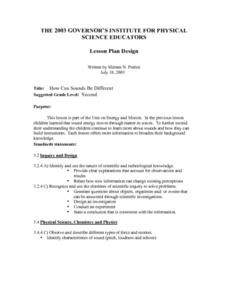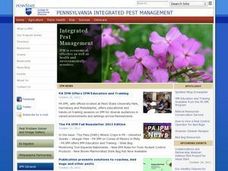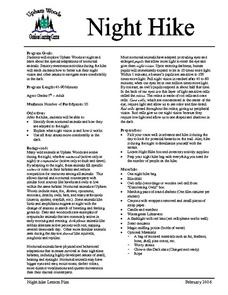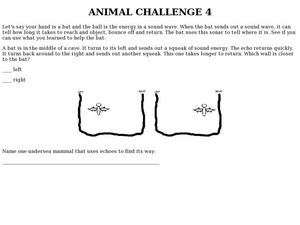Curated OER
Sound for Sight
Learners study echolocation and understand how dolphins use it to locate prey, escape predators, and navigate their environment. They view a video, "In the Wild-Dolphins with Robin Williams" and see first hand how dolphins communicate. ...
Curated OER
I, Robot, Can Do That!
Students describe the three types of underwater robots and the advantages and disadvantages of using them. In this underwater instructional activity students are given a task and identify the best robot for the job.
Curated OER
I, Robot, Can Do That!
Students describe underwater robots. In this robot instructional activity, students describe and contrast three types of underwater robots used for scientific exploration. This instructional activity includes several activities, a...
Curated OER
Pump Up the Curriculum With Pumpkins!
Young scholars complete a variety of activities as they examine "pumpkins."
Curated OER
Reading Satellite Images
Students analyze satellite images. In this astronomy lesson, students examine 3 satellite images in order to understand how satellite images are taken and what they can teach scientists.
Curated OER
Ancient Bugs
Learners describe Archaea. In this biology lesson, students examine biological communities and the role Archaea plays. Learners will compare and contrast the Archaea with bacteria and eukaryote.
Curated OER
Good Vibrations: Sound, Acoustics, Science, Sports Arenas, Olympics
Students perform a series of tasks that integrate hands-on inquiry-based activities with the Internet to explore sound and acoustics. They develop an acoustics Web page to show what they have learned.
Curated OER
Reading Maps of the East Pacific Rise
Pupils make qualitative and quantitative observations and use various maps to investigate the features of the East Pacific Rise The study actual bathymetric maps of the EPR region. They identify key features of the ridge and explore the...
Curated OER
What is a Karst?
Students examine the process that creates limestone. In this limestone lesson students complete a worksheet and participate in a lab activity.
Curated OER
This Life Stinks
Students study cold seeps and see how organisms obtain energy from methane. In this sinkholes lesson students examine the relevance of chemosynthesis to communities.
Curated OER
Entering the Twilight Zone
Students describe major features of cold seep communities and list organisms that are found in these communities. For this water habitat lesson students examine trophic levels, describe the process of chemosynthesis and list...
Curated OER
Life is Weird
Students study the organisms that are found in cold seeps and see how they interact with each-other. In this biological organism instructional activity students describe the major features of cold seeps and the process of...
Curated OER
How Can Sounds Be Different
Second graders explore energy and motion. They investigate how sound energy moves in waves. Students explore how sounds are varied and how the instruments that make those sounds are built. They observe sounds being produced and predict...
Curated OER
Drop Zone Challenge
In this physics worksheet, students construct a parachute using the materials listed on the sheet that will have the longest and closest target when dropped from a specific height. Then they record their results after three trials.
Curated OER
Sun, Shadows, Surface Structure...and the Face on Mars
Students use light and shadow information to make inferences regarding the three dimensional shapes of specific objects photographed on the surface of Mars. Limitations of the of the data provided are discussed and entries made into the...
Curated OER
Bats -- Pests or Pals?
Fourth graders examine a bat and determine if it is a pest or pal. They identify three types of bats native to the state of Pennsylvania. They also identify the parts of a bat and write a report on the bat of their choice.
Curated OER
Night Hike
Students explore Upham Woods at night and investigate about the special adaptations of nocturnal animals. They identify three nocturnal animals and how they are adapted to the night. Students explain what night vision is and how it works.
Curated OER
A Natural Connection to the Azores
Students use primary sources to examine whaling voyages, biology, and geography. In this geography lesson plan, students analyze ship logs and plot locations of animals and determine routes using latitude and longitude.
Curated OER
Animal Challenge 4
In this sound energy worksheet, students predict what happens when bats bounce sounds off of walls to communicate. Students complete 2 questions.
Hubbard's Cupboard
The Pilgrims' First Thanksgiving
Students explore holidays by participating in class singing activities. In this Thanksgiving history lesson, students discuss the importance of Thanksgiving Day and read several poems which discuss the history of Thanksgiving. Students...
Curated OER
Paper Airplane Activity
Ninth graders select and build one of five different paper airplane designs and test them for distance and for time aloft. Part of this activity is designed to explore NASA developed software, FoilSim, with respect to the lift of an...
Curated OER
Orca United Nations
Middle schoolers study the differences between sets of data and explain how organisms are adapted to their environment. In this marine mammals lesson students analyze data based on set criteria.
Curated OER
Sound - Lesson Plan
Tenth graders should know how sound is produced and state some properties of sound.
Curated OER
Battle of New Orleans
Students use the Internet, encyclopedias, and other library resources to discover basic facts about the Battle of New Orleans and the 1768 revolt by French colonists in Spanish Louisiana. They examine two websites that give information...























